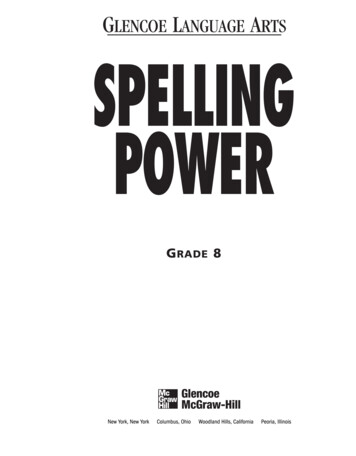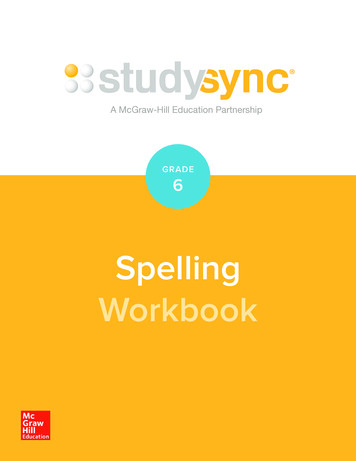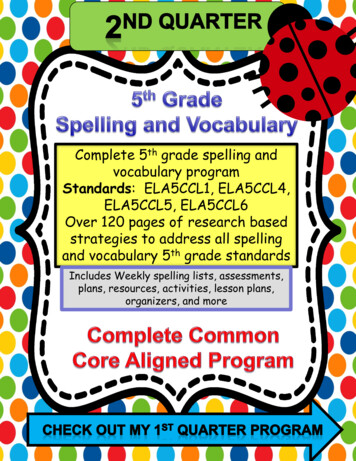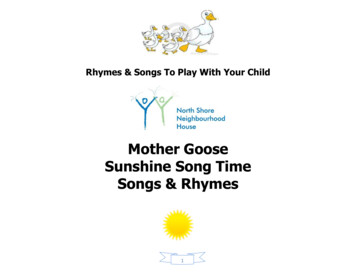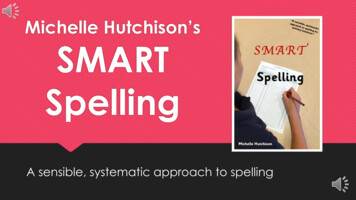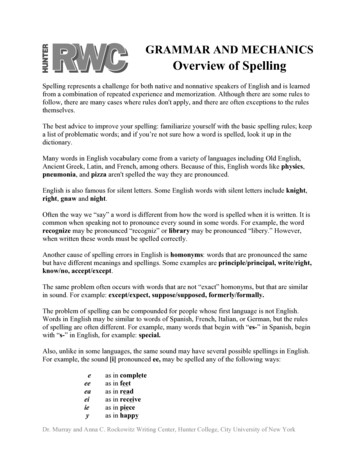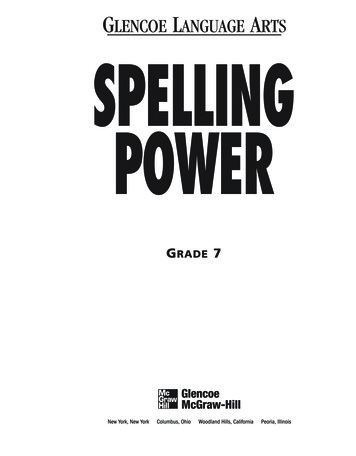
Transcription
GLENCOE LANGUAGE ARTSSPELLINGPOWERG RADE 7
To the StudentThis Spelling Power workbook provides the practice you need to improve your spelling andwriting ability and to expand your vocabulary. Each spelling lesson focuses on a single spellingpattern or concept that applies to a list of words in a Word Bank. You then have severalopportunities to practice what you’ve learned: writing the words, using them in sentences,recognizing and correcting them as you proofread, and applying the spelling pattern or concept to new words that follow the same pattern. If you have trouble with an exercise, you canalways go back to the Word Bank and Key Concepts discussion, review the material, and thenreturn to the exercise.You can keep track of your own progress and achievement in spelling by using the StudentProgress Chart, which appears on page v. With your teacher’s help, you can score your workon any lesson, quiz, or test. After you know your score, use the Scoring Scale on pages vi–viito figure your percentage. Then mark your score (or percentage correct) on the StudentProgress Chart. Share your Progress Chart with your parents or guardians as your teacherdirects.Copyright by The McGraw-Hill Companies, Inc. All rights reserved. Except as permitted under the United StatesCopyright Act of 1976, no part of this publication may be reproduced or distributed in any form or means, orstored in a database or retrieval system, without the prior written permission of the publisher.Send all inquiries to:Glencoe/McGraw-Hill8787 Orion PlaceColumbus, Ohio 43240ISBN 0-07-826240-2Printed in the United States of America1 2 3 4 5 6 7 8 9 10 024 04 03 02 01Copyright by The McGraw-Hill Companies, Inc.Glencoe/McGraw-Hill
CONTENTSStudent Progress Chart . . . . . . . . . . . . . . . . . . . . . . . . . . . . . . . . . . . . . . . . . . . . . . . . . . . . . . . . . . . . . . . . . . . . . . vScoring Scale . . . . . . . . . . . . . . . . . . . . . . . . . . . . . . . . . . . . . . . . . . . . . . . . . . . . . . . . . . . . . . . . . . . . . . . . . . . . . viUnit 1Lesson 1: Short Vowel Spellings . . . . . . . . . . . . . . . . . . . . . . . . . . . . . . . . . . . . . . . . . . . . . . . . . . . . . . . . . . . . . . . 1Lesson 2: Long Vowel Spellings . . . . . . . . . . . . . . . . . . . . . . . . . . . . . . . . . . . . . . . . . . . . . . . . . . . . . . . . . . . . . . . 3Lesson 3: Double Consonants . . . . . . . . . . . . . . . . . . . . . . . . . . . . . . . . . . . . . . . . . . . . . . . . . . . . . . . . . . . . . . . . 5Lesson 4: Perplexing Words . . . . . . . . . . . . . . . . . . . . . . . . . . . . . . . . . . . . . . . . . . . . . . . . . . . . . . . . . . . . . . . . . . 7Review Lessons 1–4 . . . . . . . . . . . . . . . . . . . . . . . . . . . . . . . . . . . . . . . . . . . . . . . . . . . . . . . . . . . . . . . . . . . . . . . . 9Unit 2Lesson 5: Spelling the \ô\ Sound . . . . . . . . . . . . . . . . . . . . . . . . . . . . . . . . . . . . . . . . . . . . . . . . . . . . . . . . . . . . . 11Lesson 6: Spelling the Schwa Sound . . . . . . . . . . . . . . . . . . . . . . . . . . . . . . . . . . . . . . . . . . . . . . . . . . . . . . . . . . 13Lesson 7: Spelling the “Seed” Sound . . . . . . . . . . . . . . . . . . . . . . . . . . . . . . . . . . . . . . . . . . . . . . . . . . . . . . . . . . 15Lesson 8: Words with ie and ei. . . . . . . . . . . . . . . . . . . . . . . . . . . . . . . . . . . . . . . . . . . . . . . . . . . . . . . . . . . . . . . 17Review Lessons 5–8 . . . . . . . . . . . . . . . . . . . . . . . . . . . . . . . . . . . . . . . . . . . . . . . . . . . . . . . . . . . . . . . . . . . . . . . 19Unit 3Lesson 9: Doubling the Final Consonant . . . . . . . . . . . . . . . . . . . . . . . . . . . . . . . . . . . . . . . . . . . . . . . . . . . . . . . 21Lesson 10: Dropping the Final Silent e . . . . . . . . . . . . . . . . . . . . . . . . . . . . . . . . . . . . . . . . . . . . . . . . . . . . . . . . . 23Lesson 11: Keeping the Final Silent e . . . . . . . . . . . . . . . . . . . . . . . . . . . . . . . . . . . . . . . . . . . . . . . . . . . . . . . . . . 25Lesson 12: The Final y . . . . . . . . . . . . . . . . . . . . . . . . . . . . . . . . . . . . . . . . . . . . . . . . . . . . . . . . . . . . . . . . . . . . . 27Review Lessons 9–12 . . . . . . . . . . . . . . . . . . . . . . . . . . . . . . . . . . . . . . . . . . . . . . . . . . . . . . . . . . . . . . . . . . . . . . 29Unit 4Lesson 13: The Suffix -ity . . . . . . . . . . . . . . . . . . . . . . . . . . . . . . . . . . . . . . . . . . . . . . . . . . . . . . . . . . . . . . . . . . . 31Lesson 14: The Suffixes -ance and -ence . . . . . . . . . . . . . . . . . . . . . . . . . . . . . . . . . . . . . . . . . . . . . . . . . . . . . . . 33Lesson 15: The Suffix -ion. . . . . . . . . . . . . . . . . . . . . . . . . . . . . . . . . . . . . . . . . . . . . . . . . . . . . . . . . . . . . . . . . . . 35Lesson 16: Adding Prefixes . . . . . . . . . . . . . . . . . . . . . . . . . . . . . . . . . . . . . . . . . . . . . . . . . . . . . . . . . . . . . . . . . . 37Review Lessons 13–16 . . . . . . . . . . . . . . . . . . . . . . . . . . . . . . . . . . . . . . . . . . . . . . . . . . . . . . . . . . . . . . . . . . . . . 39Unit 5Lesson 17: The Prefix ad- . . . . . . . . . . . . . . . . . . . . . . . . . . . . . . . . . . . . . . . . . . . . . . . . . . . . . . . . . . . . . . . . . . . 41Lesson 18: The Prefix con- . . . . . . . . . . . . . . . . . . . . . . . . . . . . . . . . . . . . . . . . . . . . . . . . . . . . . . . . . . . . . . . . . . 43Lesson 19: Number Prefixes . . . . . . . . . . . . . . . . . . . . . . . . . . . . . . . . . . . . . . . . . . . . . . . . . . . . . . . . . . . . . . . . . 45Lesson 20: The Negative Prefix in- . . . . . . . . . . . . . . . . . . . . . . . . . . . . . . . . . . . . . . . . . . . . . . . . . . . . . . . . . . . . 47Review Lessons 17–20 . . . . . . . . . . . . . . . . . . . . . . . . . . . . . . . . . . . . . . . . . . . . . . . . . . . . . . . . . . . . . . . . . . . . . 49Unit 6Lesson 21: The Latin Word Roots scrib and fer . . . . . . . . . . . . . . . . . . . . . . . . . . . . . . . . . . . . . . . . . . . . . . . . . . 51Lesson 22: The Latin Word Roots voc and mit . . . . . . . . . . . . . . . . . . . . . . . . . . . . . . . . . . . . . . . . . . . . . . . . . . . 53Lesson 23: Word Easily Misspelled. . . . . . . . . . . . . . . . . . . . . . . . . . . . . . . . . . . . . . . . . . . . . . . . . . . . . . . . . . . . 55Lesson 24: More Words Easily Misspelled . . . . . . . . . . . . . . . . . . . . . . . . . . . . . . . . . . . . . . . . . . . . . . . . . . . . . . 57Review Lessons 21–24 . . . . . . . . . . . . . . . . . . . . . . . . . . . . . . . . . . . . . . . . . . . . . . . . . . . . . . . . . . . . . . . . . . . . . 59Spelling PowerGrade 7iii
Unit 7Lesson 25: Plurals of Nouns Ending in a Vowel o . . . . . . . . . . . . . . . . . . . . . . . . . . . . . . . . . . . . . . . . . . . . . . 61Lesson 26: Plurals of Nouns Ending in a Consonant o . . . . . . . . . . . . . . . . . . . . . . . . . . . . . . . . . . . . . . . . . . 63Lesson 27: Plurals of Special Nouns. . . . . . . . . . . . . . . . . . . . . . . . . . . . . . . . . . . . . . . . . . . . . . . . . . . . . . . . . . . 65Lesson 28: Plurals of Nouns Ending in f and fe . . . . . . . . . . . . . . . . . . . . . . . . . . . . . . . . . . . . . . . . . . . . . . . . . . 67Review Lessons 25–28 . . . . . . . . . . . . . . . . . . . . . . . . . . . . . . . . . . . . . . . . . . . . . . . . . . . . . . . . . . . . . . . . . . . . . 69Unit 8Lesson 29: Unusual Plurals . . . . . . . . . . . . . . . . . . . . . . . . . . . . . . . . . . . . . . . . . . . . . . . . . . . . . . . . . . . . . . . . . . 71Lesson 30: Spelling Possessive Forms . . . . . . . . . . . . . . . . . . . . . . . . . . . . . . . . . . . . . . . . . . . . . . . . . . . . . . . . . 73Lesson 31: Spelling Compound Words . . . . . . . . . . . . . . . . . . . . . . . . . . . . . . . . . . . . . . . . . . . . . . . . . . . . . . . . . 75Lesson 32: Words Easily Misspelled . . . . . . . . . . . . . . . . . . . . . . . . . . . . . . . . . . . . . . . . . . . . . . . . . . . . . . . . . . 77Review Lessons 29–32 . . . . . . . . . . . . . . . . . . . . . . . . . . . . . . . . . . . . . . . . . . . . . . . . . . . . . . . . . . . . . . . . . . . . . 79ivGrade 7Spelling Power
STUDENT PROGRESS CHARTFill in the chart below with your scores, using the scoring scale on the next page.Name:LessonPretestOral QuizUnit 132ReviewSpelling PowerGrade 7v
SCORING SCALEUse this scale to find your score. Line up the number of items with the number correct. For example, if 15out of 16 items are correct, your score is 93.7 percent (see grayed area).Number of ItemsNumber 43.83.73.63.43.33.23.132.92.92.82.72.62.62.5vi Grade .764.562.560.658.857.155.65452.651.350Spelling Power
Number of ItemsNumber 89.587.285Spelling Power353637383910097.2 10094.6 97.3 10092.1 94.7 97.3 10089.7 92.3 94.9 97.4 10087.5 90 92.5 95 97.540100Grade 7vii
Name Date Class Lesson 1: Short Vowel SpellingsWord gitalsymbolicenduranceinfinityculturalKey Concepts1. The short vowel sounds are \a\ as in hat, \e\ as innet, \i\ as in did, \o\ as in lot, and \u\ as in cup.2. Short vowel sounds are usually spelled with singleletters.bankruptcomicSpelling PracticedCopyright by The McGraw-Hill Companies, Inc.Put the words from the Word Bank in alphabetical order. Circle the letters in each word that spellshort vowel sounds: \a\, \e\, \i\, \o\, and \u\.1.6.2.7.3.8.4.9.5.10.Spelling in ContextdWrite the word from the Word Bank that best completes each sentence.1. At the annual winter art show one entrant confided, “To beshowing.”2. He had been working with3. He focused on4. To generate some of his images, he used5. The many artworks sold wereSpelling Power, this is my firstart for several years.geometric shapes and primary colors.processing.that the show was a success.Grade 71
Name Date Class LESSON 1 continuedProofreading PracticedRead the paragraph below. Find the five misspelled words and circle them. Then, on the numberedlines, write the correct spelling for each circled word.Between the Tigris and Euphrates Rivers, in the land we now call Iraq, lay the maignificentancient city of Babylon. At its center rose the king’s palace, lush with rooftop gardens thatseemed to stretch out to infinety. Babylon was a coultural showcase. On its gated outer walls,bricks enameled in blue, green, and pink formed symbaulic images of dragons and bulls.Babylon’s walls are models of indurance—some have stood for over four thousand years.1.4.2.5.3.Spelling ApplicationdListed below are five more words that reflect the Key Concepts you have learned. Circle the shortvowels in these words. Then use the words to complete the imaginary book titles that follow.fantastichospitality1. Instant2. Staying Calm and3. Introduction to5. You Can Ace Tests with2Grade 7randomstatistics: Feeding Unexpected Guests, by Jack N. D. Bachs, by Don Blowyerkool, by D. Mean, Andy Median, and D. ModeHobby, by Paddy O’FurnitureGuesswork, by Liza Bluestreak and Doña BuyittSpelling PowerCopyright by The McGraw-Hill Companies, Inc.4. Carpentry: Aplacid
Name Date Class Lesson 2: Long Vowel SpellingsWord yrepeatedlyspeculatealthoughcubicleKey ConceptsLong vowel sounds are often spelled with vowel combinations. The \ \ sound can be spelled ai, ay, or a e.playfulgrapestain The \ƒ\ sound can be spelled ea, ee, y, i e, ore e.seekhandyreachmachinecompete The \ª\ sound can be spelled igh, y, or i e.skyprizesighThe \ \ sound can be spelled oa, ow, ough, oro e.blowdoughcloseroadThe \ \ sound can be spelled ou, ew, eu, u, ue, oru e.fewfeudyoucubiclecueuseSpelling PracticedCopyright by The McGraw-Hill Companies, Inc.Choose the words from the Word Bank that use the patterns described. Write your choices on thelines.1. \ \ spelled ai and ay6. \ \ spelled a e2. \ƒ\ spelled ee7. \ \ spelled u3. \ \ spelled eu8. \ª\ spelled igh4. \ \ spelled ou9. \ƒ\ spelled ea and y5. \ª\ spelled i e10. \ª\ spelled ySpelling in ContextdWrite the word from the Word Bank that best completes each sentence.1. Lukewarm cheeseburgers seem to be the2. It wouldsoups, and other healthy foods.many of us if the cafeteria food included crisp salads, homemade3. The new kitchen was designed with a private4. The changes will5. NoSpelling Powerof our cafeteria menu.for the head chef.with National Nutrition Week.will be said for the demise of the old cafeteria.Grade 73
Name Date Class LESSON 2 continuedProofreading PracticedRead the paragraph below. Find the five misspelled words and circle them. Then, on the numberedlines, write the correct spelling for each circled word.Over the years, scientists have repetedley suggested that there may be a tenth planetbeyond Pluto. Now astronomers have new information to enliten us. After studying the orbitsof many comets, astronomers speculait that the “planet” may actually be a brown dwarf—asmall, dark star. Altho they cannot yet guarantie that the star is there, such a star would makeour sun part of a binary star system.1.3.2.4.5.Spelling ApplicationdListed below are eight more words that reflect the Key Concepts you have learned. Circle the lettersthat spell long vowel sounds in each word. (Refer to the Key Concepts for help.) Then use the wordsto complete the crossword ant213u45el9olceea10n11c7insveo86Copyright by The McGraw-Hill Companies, Inc.Across1. destroyed ordecayed7. related to certaintimes of year8. out of date10. following insequence11. to mock13. to hold oneselfback14. a 4Down2. an oppressive ruler3. deeply upsetting4. long periods of time5. a thin cloth covering6. less dirty9. at one time12. Emergency Room (abbrev.)4Grade 7Spelling Power
Name Date Class Lesson 3: Double ConsonantsWord ntfulfillassistantsatellitesuccessfulKey Concepts1. Double consonants often follow short vowel sounds.illnessmotto2. Double consonants usually represent a single unit ofsound.occupynagging3. Sometimes double consonants represent twounits of sound.succeed (\k\ and \s\)fishhook (\sh\ and \h\)Spelling PracticedPut the words from the Word Bank in alphabetical order and circle the double consonants. Aftereach word, write 1 for each set of double consonants representing one unit of sound. Write 2 foreach set of double consonants representing two units of sound.Copyright by The McGraw-Hill Companies, Inc.Example:access 2, 11.6.2.7.3.8.4.9.5.10.Spelling in ContextdWrite the word from the Word Bank that best completes each sentence.1. Thetwinkled as it soared across the night sky.2. The space launch was the result of anbetween several nations.3. Scientists were quick toproject.4. Thanks to theirthe international team of engineers who worked on the, the launch was flawless.5. Each participant was treated as an ally, not anSpelling Power.Grade 75
Name Date Class LESSON 3 continuedProofreading PracticedRead the paragraph below. Find the five misspelled words and circle them. Then, on the numberedlines, write the correct spelling for each circled word.The timber wolf cub Akela was a chalenge to keepers at the San Diego Zoo. Could the shyand withdrawn cub, who had been purchased from a breeder, make a sucsessful transition tozoo life? The oficial plan was to give Akela a “big sister.” Keepers hoped that Nala, a younggolden retriever, would fullfil the requirement. Soon the outgoing Nala had Akela romping andplaying. Zookeepers call Nala their best asistant.1.4.2.5.3.Spelling ApplicationdBelow are eight more words reflecting the Key Concepts that you have learned. Circle the doubleconsonants. After each word, write 1 if the double consonants represent one unit of sound or 2 ifthey represent two units of sound. Use the words to complete the Tom Swiftie puns that follow.accessbarrenfortressgrammatical1. “Here on our photo safari, we haveintently.3. “The southern African plains are4. “If you5. “They use their horns as6. “No one could sneak into the7. “A mirage is a kind of8. “What covers the bodies of most6Grade 7mammalsoffensiveto the best camping equipment,” said Tomerrors in our brochures,” said Tom tensely.and parched in the summer,” said Tom dryly.the rhinos, they may charge,” said Tom flatly.weapons,” said Tom pointedly.of Old Zimbabwe,” said Tom guardedly.,” said Tom insightfully.?” asked Tom fuzzily.Spelling PowerCopyright by The McGraw-Hill Companies, Inc.2. “I’m proud that there are noillusionirritate
Name Date Class Lesson 4: Perplexing WordsWord tlydebriscamouflagefatigueKey Concepts1. Although the sound of a word can often helpyou to spell it correctly, the spellings of manyEnglish words are difficult to rememberbecause the spellings reflect pronunciationsfrom other languages. For example, in MiddleEnglish, the consonant b in subtle wassounded. Modern English drops the sound butkeeps the spelling.2. Some of the most difficult words to spell containunpronounced vowels. These silent vowels may alsoreflect patterns of other languages. For example,Vague and other -gue words come from French.Spelling PracticedCopyright by The McGraw-Hill Companies, Inc.Choose the word from the Word Bank that fits each pronunciation. Write your choices on the lines.1. \d‰ brƒ \6. \v g\2. \f‰ tƒg \7. \dª ‰ fram \3. \k os\8. \sut ‰l\4. \ven j‰ns\9. \kam ‰ fläzh\5. \dª ‰ lôg \10. \gast lƒ\Spelling in ContextdWrite the word from the Word Bank that best completes each sentence below.1. The Junior Theater is staging Macbeth, Shakespeare’s play about ambition and2. A voice coach is helping actors with the play’s3. “Speak from your., not just from your throat,” she advises.4. In some scenes, voices have to sound eerie and5. The actors hope to create aSpelling Power.but disturbing sense of dread.Grade 77
Name Date Class LESSON 4 continuedProofreading PracticedRead the paragraph below. Find the five misspelled words and circle them. Then, on the numberedlines, write the correct spelling for each circled word.Petra had the perfect camoflauge. Deep in a desert gorge, this two-thousand-year-old citywas carved from sandstone walls in suttle shades of pink and tan. A stop in the “stone city”must have eased the fatige of many a traveler, for Petra had running water piped through asystem of channels and cisterns. The city has survived despite Mideastern political caos. Today,amid the debrie of millennia, Petra’s ancient structures can still be seen.1.4.2.5.3.Spelling ApplicationdListed below are five more words that reflect the Key Concepts you have learned. Use the words tofill in the “terse verse” rhymed definitions that follow.aerialexcessgrotesque1. bizarre ballet move:mechanismarabesque2. covering a TV antenna with earth:burial3. overly long street name:father: unhappy pappy5. invisible8addressGrade 7Copyright by The McGraw-Hill Companies, Inc.4.wretched: unseen machineSpelling Power
Name Date Class Unit 1: Review Lessons epeatedlyvagueChoose the words from the list that best complete the “terse verse” rhymes. Write your choices onthe lines.1.at the boundary line: disorder at the border2.snoop: computer intruder3. trash in the ocean:4. isin the seaof campground shelters: represents tents5. beand catch people’s interest: understate and fascinate6. educate the giant:the titan7. meet the terms of the final testament:the will8. endless supply of white fudge :of divinity9. hard-to-grasp agreement:Copyright by The McGraw-Hill Companies, Inc.10. explaining whatcontractmeans: defining streamliningChoose the words from the list that best complete the sentences. Write your choices on the lines.11. Leona wants to play the tuba,her parents suggest the piccolo.12. When Leona asks her parents why they prefer the piccolo, they can only give her aexplanation of their concerns.13. For example, they ask if Leona can give an absoluteneighbors.14. She patiently andthat she won’t disturb thereassures them that she will practice softly.15. She likes overcoming obstacles, so she relishes the16. The brass section is important; it’s thethat the tuba offers.of the marching band.17. A tuba player needs muscles as well as musical ability to beat band tryouts.18. She practices deep breathing to strengthen her.19. She jogs and lifts weights to build stamina and.20. Leona has just one objection: theSpelling Powerband uniforms are lime green and orange.Grade 79
Name Date Class Proofreading ApplicationLessons 1–4Read the updated fairy tale below. Find the twenty misspelled words and circle them. Then, on thenumbered lines, write the correct spelling for each circled 7.14.10Grade 7Spelling PowerCopyright by The McGraw-Hill Companies, Inc.Once there lived a king who wouldn’t let his daughter marry. The queen was in completeacord. “We’ll be candide, Rapunzel, dear,” they told the princess. “There is no evadence we willever find a suitor worthy of you.”“But I have fundementel objections to being single!” wailed the princess. “This is gastly! Ifyou do not let me find a husband, I guaranty I will run away!”After that dialouge, the king began to speceulate about the wisdom of leaving Rapunzelunguarded. He locked her in a maignificent tower deep in the forest. There she spent her daysclamoring for vengence, silent only when fatig overcame her.Meanwhile, following culturel norms, the prince of a nearby satelite state set off on a quest.Althou he was awed by the tower, he was confused by the sounds of fury coming from it. Heprudently donned camaflauge gear and hid in the underbrush.Soon there appeared—an oponent? No, it was only the king’s asistant. “Rapunzel, Rapunzel!”the servant cried. “Let down your hair!” From a high window, the princess uncoiled her longbraid. The servant tied a basket to the braid, and Rapunzel pulled up her supper.“What luck that the servant’s arrival should coinciede with mine!” thought the prince. Assoon as the servant left, he emerged and called, “Rapunzel, Rapunzel, let down your hair!”Rapunzel looked down to see a man dressed as a gooseberry bush. “Well,” she thought, “Icomend his creativity . . .” She uncoiled her braid, and the prince began to climb up.“Yowch!” howled Rapunzel. “How much do you weigh?”“Patience, sweet petunia! Soon you’ll be mine!”But Rapunzel reached for the scissors. “Why should I go bald just to gratafy you? I’m aprincess, not a climbing rope. Go find yourself another petunia. And lose some weight!”Snip! The prince was history. Rapunzel made peace with her parents, inherited the kingdom,and lived happily ever after.
Name Date Class Lesson 5: Spelling the \ô\ SoundWord erprecautionnotoriousflawlessseaboardKey Concepts1. Spell the \ô\ sound au or aw in most words.faultawfuldrawnAugust2. Spell the \ô\ sound a, augh, or ough in somewords.daughteroughthalt3. Spell the \ôr\ sound or or oar in many words.coarseformSpelling PracticedCopyright by The McGraw-Hill Companies, Inc.Put the words from the Word Bank in alphabetical order. Circle the letters that spell the \ô\ or \ôr\sound in each word.1.6.2.7.3.8.4.9.5.10.Spelling in ContextdWrite the word from the Word Bank that best completes each sentence. Be sure to spell the \ô\ and\ôr\ sounds correctly.1. On Africa’s eastern2. There Swahili merchants traded3. The4. The result was the5. Thougharea.Spelling Powerlay the rich city-state of Kilwa.goldwork for goods from India and China.Portuguese fleet attacked Kilwa in 1505.of many citizens.by memories of the attack, the Swahili soon regained control of theGrade 711
Name Date Class Proofreading PracticedRead the paragraph below. Find the five misspelled words and circle them. Then, on the numberedlines, write the correct spelling for each circled word.How to appaul a musician: Try putting a musical instrument in a freezer. Surprisingly, somethoutful artists use this technique on trumpets, horns, and other brass instruments. With theright precoutions, freezing won’t harm the instruments. Players claim that after freezing, brassgains a “freer,” more athentic tone. The difference, they say, is clearly aughdible.1.4.2.5.3.Spelling ApplicationdListed below are eight more words that reflect the Key Concepts you have learned. Circle the lettersthat spell the \ô\ or \ôr\ sound in each ysprawlingDo you speak Pig Latin? In this made-up “language,” you take away the first consonant from thefront of a word. Then add the consonant to an extra syllable at the end of the word. For example,Pig Latin becomes Ig-Pay Atin-Lay. Write the “translation” of each Pig Latin word below.Grade 75. oral-may2. aught-nay6. audy-gay3. oarding-hay7. awling-spray4. inority-may8. autical-naySpelling PowerCopyright by The McGraw-Hill Companies, Inc.121. auled-may
Name Date Class Lesson 6: Spelling the Schwa SoundWord usphilosopherminimumfacultyvigorKey Concepts1. The schwa (‰) represents an indistinct vowelsound in an unstressed syllable.2. Any unstressed vowel may spell the schwa sound.edifygallon itemabove cactus3. Spell the \‰l\ sound al, el, il, ol, ul, or le.trialjeweltendrilviolinfear
vi Grade 7 Spelling Power SCORING SCALE Use this scale to find your score. Line up the number of items with the number correct. For example, if 15 out of 16 items are correct, your score is 93.7 percent (see gray
